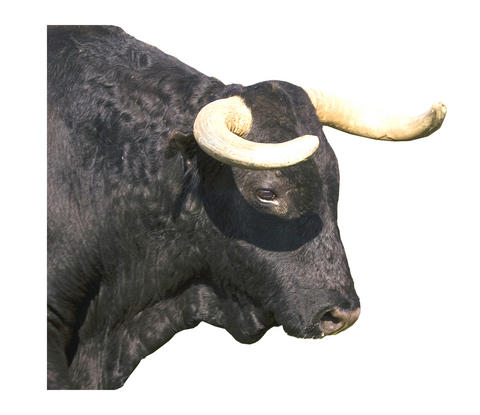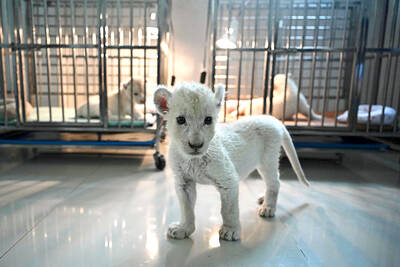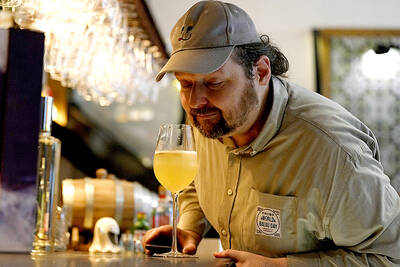Alcalde, a hulking black bull, is quite the stud. He sires up to 40 calves a year, most of them top-grade fighters, even though in human terms he'd be almost 80 years old and is nearing the end of his life.
Victoriano del Rio, a fifth-generation breeder of fighting bulls, cringes at the thought of losing a creature with such good genes. So he is going to clone him - an unprecedented marriage of technology and the Spanish-speaking world's ancient, beloved pastime.
"I am extremely fond of this bull," Del Rio said at his ranch in this town outside Madrid, watching 16-year-old Alcalde graze with some of his latest offspring - mere toys next to their prolific, half-tonne father. "He has given us tremendous satisfaction."

PHOTO: AP
Del Rio is not alone in the adventure. Rancher Jose Manuel Fernandez in Mexico plans to replicate Zalamero, another revered, aging bull that achieved the rare feat of dodging death in the ring: In 1994 Zalamero put up such a relentless fight one autumn day that judges spared his life. Since then Zalamero, too, has been a priceless stud.
Fernandez is so bullish on cloning he envisions a future in which an afternoon at the arena - usually three matadors taking on two bulls each - might involve six genetically identical twins created from the same beast.
"What I am looking for is a path toward innovation in bullfighting," Fernandez said from Mexico City. "We are trying to give the show greater quality."
If all goes as planned, Zalamero II - or several of them, because Fernandez is trying for four or five - will be born in November or December of this year. Alcalde's clone would be born in May or June of next year.
Both breeders have hired ViaGen, a cloning company based in Austin, Texas, to do the job. The technique is essentially the same one used in 1996 to copy the sheep Dolly, the world's first cloned mammal.
A ViaGen spokesman, speaking on condition of anonymity, confirmed the orders from Del Rio and Fernandez, but would not comment on pregnancies or expected birth dates. He said the breeders would pay standard cattle cloning prices: US$17,500 for the first calf, US$15,000 for the second, US$12,500 for the third and US$10,000 for the fourth and beyond.
ViaGen has cloned about 300 mammals, including show pigs, rodeo horses and bucking broncos, since its founding in 2002. But this is the world's first go at cloning the breed that takes on matadors in the deadly minuet of bullfighting.
"It is a new field that is opening up before us," said Eduardo Miura, veteran breeder of a line of Spanish bulls so fierce the very word Miura has become part of the language (to "act like a Miura" is to become furious). He said breeders in Spain are generally supportive of Del Rio's cloning plans.
But question marks abound. It's one thing to pass on a carbon copy of a fighting or stud bull's DNA, quite another to expect the new animal to mimic its template.
Only as much as 40 percent of an animal's behavior is attributable to its genes, said Javier Canon, a geneticist at Madrid's Complutense University who specializes in fighting bulls.
External factors account for the rest.
And even if the sons of a great fighting bull were always great fighting bulls themselves there are much cheaper and more effective ways to harvest those valuable genes, such as using the father's semen for artificial insemination.
"If you ask me about this project from a technical point of view, in terms of genetic progress it serves no purpose whatsoever," Canon said.
Even in its traditional mode, bull breeding is a slow, hit-or-miss business. Studs are crossed with cows carefully selected for feistiness through simulated fights in the ring, albeit without bloodshed. Then the rancher has to wait a few years for the resulting bull to grow up, and see if it has the right stuff.
"Theoretically, two plus two are four. In this, when the time comes, it might not be four, but rather minus three. The results are very elastic," Miura said from his ranch outside Seville.
"Indeed, it is an experiment," Del Rio said of his cloning project. "We are going to investigate. Investigation always carries with it the possibility that you are wrong."
A ViaGen team will come to Spain in a few weeks to collect skin samples from Alcalde and take them back to Texas to start preparing embryos. Fernandez's endeavor is at a more advanced stage; he said the embryos are already growing and will be implanted in cows this month in Mexico. ViaGen is also in talks with other breeders in Spain.

Behind a car repair business on a nondescript Thai street are the cherished pets of a rising TikTok animal influencer: two lions and a 200-kilogram lion-tiger hybrid called “Big George.” Lion ownership is legal in Thailand, and Tharnuwarht Plengkemratch is an enthusiastic advocate, posting updates on his feline companions to nearly three million followers. “They’re playful and affectionate, just like dogs or cats,” he said from inside their cage complex at his home in the northern city of Chiang Mai. Thailand’s captive lion population has exploded in recent years, with nearly 500 registered in zoos, breeding farms, petting cafes and homes. Experts warn the

No one saw it coming. Everyone — including the Chinese Nationalist Party (KMT) — expected at least some of the recall campaigns against 24 of its lawmakers and Hsinchu Mayor Ann Kao (高虹安) to succeed. Underground gamblers reportedly expected between five and eight lawmakers to lose their jobs. All of this analysis made sense, but contained a fatal flaw. The record of the recall campaigns, the collapse of the KMT-led recalls, and polling data all pointed to enthusiastic high turnout in support of the recall campaigns, and that those against the recalls were unenthusiastic and far less likely to vote. That

The unexpected collapse of the recall campaigns is being viewed through many lenses, most of them skewed and self-absorbed. The international media unsurprisingly focuses on what they perceive as the message that Taiwanese voters were sending in the failure of the mass recall, especially to China, the US and to friendly Western nations. This made some sense prior to early last month. One of the main arguments used by recall campaigners for recalling Chinese Nationalist Party (KMT) lawmakers was that they were too pro-China, and by extension not to be trusted with defending the nation. Also by extension, that argument could be

The centuries-old fiery Chinese spirit baijiu (白酒), long associated with business dinners, is being reshaped to appeal to younger generations as its makers adapt to changing times. Mostly distilled from sorghum, the clear but pungent liquor contains as much as 60 percent alcohol. It’s the usual choice for toasts of gan bei (乾杯), the Chinese expression for bottoms up, and raucous drinking games. “If you like to drink spirits and you’ve never had baijiu, it’s kind of like eating noodles but you’ve never had spaghetti,” said Jim Boyce, a Canadian writer and wine expert who founded World Baijiu Day a decade